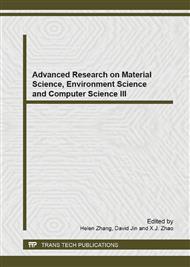[1]
R. Gupta, Q. Beg, P. Lorenz, Bacterial alkaline proteases: molecular approaches and industrial applications, Applied microbiology and biotechnology 59 (2002) 15-32.
DOI: 10.1007/s00253-002-0975-y
Google Scholar
[2]
J. Singh, R. Vohra, D. Sahoo, Alkaline protease from a new obligate alkalophilic isolate of Bacillus sphaericus, Biotechnology letters 21 (1999) 921-924.
Google Scholar
[3]
Q. Zhang, E. Smith, J. Shen, D. Bishop, An ethoxylated alkyl phosphate (anionic surfactant) for the promotion of activities of proteases and its potential use in the enzymatic processing of wool, Biotechnol. lett. 28 (2006) 717-723.
DOI: 10.1007/s10529-006-9049-z
Google Scholar
[4]
C.G. Kumar, H. Takagi, Microbial alkaline proteases: from a bioindustrial viewpoint, Biotechnol. adv. 17 (1999) 561-594.
Google Scholar
[5]
K. -H. Maurer, Detergent proteases, Curr. opin. Biotechnol. 15 (2004) 330-334.
Google Scholar
[6]
K. Cheng, F. -P. Lu, M. Li, L. -L. Liu, X. -M. Liang, Purification and biochemical characterization of a serine alkaline protease TC4 from a new isolated Bacillus alcalophilus TCCC11004 in detergent formulations, Afr. J. Biotechnol . 9 (2010).
Google Scholar
[7]
Y.A.V. Yomantas, E.G. Abalakina, L.I. Golubeva, L.Y. Gorbacheva, S.V. Mashko, Overproduction of Bacillus amyloliquefaciens extracellular glutamyl-endopeptidase as a result of ectopic multi-copy insertion of an efficiently-expressed mpr gene into the Bacillus subtilis chromosome, Microbial. Cell. Factories 10 (2011).
DOI: 10.1186/1475-2859-10-64
Google Scholar
[8]
K.E. Tyo, P.K. Ajikumar, G. Stephanopoulos, Stabilized gene duplication enables long-term selection-free heterologous pathway expression, Nat. Biotechnol . 27 (2009) 760-765.
DOI: 10.1038/nbt.1555
Google Scholar
[9]
S. -C. Wu, S. -L. Wong, Development of improved pUB110-based vectors for expression and secretion studies in< i> Bacillus subtilis</i>, J. Biotechnol. 72 (1999) 185-195.
DOI: 10.1016/s0168-1656(99)00101-7
Google Scholar
[10]
L. Keay, P.W. Moser, B.S. Wildi, Proteases of the genus Bacillus. II. Alkaline proteases, Biotechnol bioengin. 12 (1970) 213-249.
DOI: 10.1002/bit.260120206
Google Scholar
[11]
A.D. Holland, H.M. Rothfuss, M.E. Lidstrom, Development of a defined medium supporting rapid growth for Deinococcus radiodurans and analysis of metabolic capacities, Appl. Microbiol. Biotechnol. 72 (2006) 1074-1082.
DOI: 10.1007/s00253-006-0399-1
Google Scholar
[12]
E. Amador, J.F. Martín, J.M. Castro, A Brevibacterium lactofermentum 16S rRNA gene used as target site for homologous recombination, FEMS microbiology letters 185 (2000) 199-204.
DOI: 10.1111/j.1574-6968.2000.tb09062.x
Google Scholar
[13]
C. Condon, D. Liveris, C. Squires, I. Schwartz, C.L. Squires, rRNA operon multiplicity in Escherichia coli and the physiological implications of rrn inactivation, J. Bacteriol. 177 (1995) 4152-4156.
DOI: 10.1128/jb.177.14.4152-4156.1995
Google Scholar
[14]
G. Rossolini, M. Riccio, E. Gallo, C. Galeotti, Kluyveromyces lactis rDNA as a target for multiple integration by homologous recombination, Gene. 119 (1992) 75-81.
DOI: 10.1016/0378-1119(92)90068-z
Google Scholar
[15]
A. Pisabarro, A. Correia, J.F. Martín, Characterization of the rrnB operon of the plant pathogen Rhodococcus fascians and targeted integrations of exogenous genes at rrn loci, Appl. Environ. Microbiol . 64 (1998) 1276-1282.
DOI: 10.1128/aem.64.4.1276-1282.1998
Google Scholar


